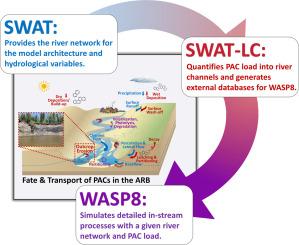阿萨巴斯卡河流域多环芳香族化合物的模拟:综合模型和见解
IF 12.4
1区 环境科学与生态学
Q1 ENGINEERING, ENVIRONMENTAL
引用次数: 0
摘要
加拿大艾伯塔省阿萨巴斯卡河流域(ARB)油砂开采中产生的多环芳香族化合物(PACs)的环境风险已成为人们关注的问题。它们复杂的环境行为使机制、盆地尺度的建模复杂化,使得难以评估它们的来源、命运/运输以及对暴露生物的潜在影响的相关性。为了应对这些挑战,开发了基于python的土壤水分评估工具-负载计算器(SWAT- lc),并与SWAT和水质分析模拟程序8 (WASP8)模型相结合,以描述pac在ARB中的行为,包括通过地表径流、土壤侧流、地下水基流、直接通量和露头/沉积物侵蚀的运输。选择了蒽、萘、c4 -菲/蒽和c4 -二苯并噻吩,以证明我们的建模方法对岩石成因和热成因、不同物理化学性质和不同环境相关性的pac的适用性。模拟结果表明,包括流动驱动的自然露头侵蚀过程的描述显着提高了模型的性能,而温度依赖机制显示出改善侵蚀过程表征的潜力。屈的模型表现良好,总体而言,C4-phenanthrenes /蒽和C4-dibenzothiophenes(了无 = 0.19∼0.75 d = 0.66∼0.95,PBIAS = -23∼47%中产和下游站),但其性能较弱萘(了无 = -2.16∼-0.40 d = 0.35∼0.53,PBIAS = 17日∼51%目标站)。尽管如此,通过整合一套全面的机制过程,该模型现在非常适合于情景测试,特别是对于具有重大环境和健康相关性的代表性pac。本文章由计算机程序翻译,如有差异,请以英文原文为准。

Simulation of Polycyclic Aromatic Compounds in the Athabasca River Basin: Integrated Models and Insights
The environmental risks associated with polycyclic aromatic compounds (PACs) stemming from oil sands mining have become a concern in the Athabasca River basin (ARB), Alberta, Canada. Their complex environmental behavior complicates mechanistic, basin-scale modeling, making it difficult to assess the relevance of their sources, fate/transport, and potential impacts on exposed organisms. To address these challenges, a Python-based Soil Water Assessment Tool-Load Calculator (SWAT-LC) was developed and coupled with SWAT and Water Quality Analysis Simulation Program 8 (WASP8) models to describe PACs’ behavior in the ARB, including transport via surface runoff, soil lateral flow, groundwater baseflow, direct flux, and outcrop/sediment erosion. Chrysene, naphthalene, C4-phenanthrenes/anthracenes, and C4-dibenzothiophenes were selected to demonstrate the applicability of our modeling approach for simulating PACs of petrogenic and pyrogenic origins, diverse physico-chemical properties, and varying environmental relevance. The simulation results indicated that including the description of flow-driven natural outcrop erosion processes significantly enhanced model performance, while the temperature-dependent mechanism showed potential for improving erosion process characterization. Overall, the model performed well for chrysene, C4-phenanthrenes/anthracenes, and C4-dibenzothiophenes (NSE = 0.19∼0.75, d = 0.66∼0.95, PBIAS = -23∼47% at middle and downstream stations), but its performance was weaker for naphthalene (NSE = -2.16∼-0.40, d = 0.35∼0.53, PBIAS = 17∼51% at all target stations). Nonetheless, by integrating a comprehensive set of mechanistic processes, this model is now well-suited for scenario testing, especially for representative PACs that have major environmental and health relevance.
求助全文
通过发布文献求助,成功后即可免费获取论文全文。
去求助
来源期刊

Water Research
环境科学-工程:环境
CiteScore
20.80
自引率
9.40%
发文量
1307
审稿时长
38 days
期刊介绍:
Water Research, along with its open access companion journal Water Research X, serves as a platform for publishing original research papers covering various aspects of the science and technology related to the anthropogenic water cycle, water quality, and its management worldwide. The audience targeted by the journal comprises biologists, chemical engineers, chemists, civil engineers, environmental engineers, limnologists, and microbiologists. The scope of the journal include:
•Treatment processes for water and wastewaters (municipal, agricultural, industrial, and on-site treatment), including resource recovery and residuals management;
•Urban hydrology including sewer systems, stormwater management, and green infrastructure;
•Drinking water treatment and distribution;
•Potable and non-potable water reuse;
•Sanitation, public health, and risk assessment;
•Anaerobic digestion, solid and hazardous waste management, including source characterization and the effects and control of leachates and gaseous emissions;
•Contaminants (chemical, microbial, anthropogenic particles such as nanoparticles or microplastics) and related water quality sensing, monitoring, fate, and assessment;
•Anthropogenic impacts on inland, tidal, coastal and urban waters, focusing on surface and ground waters, and point and non-point sources of pollution;
•Environmental restoration, linked to surface water, groundwater and groundwater remediation;
•Analysis of the interfaces between sediments and water, and between water and atmosphere, focusing specifically on anthropogenic impacts;
•Mathematical modelling, systems analysis, machine learning, and beneficial use of big data related to the anthropogenic water cycle;
•Socio-economic, policy, and regulations studies.
 求助内容:
求助内容: 应助结果提醒方式:
应助结果提醒方式:


